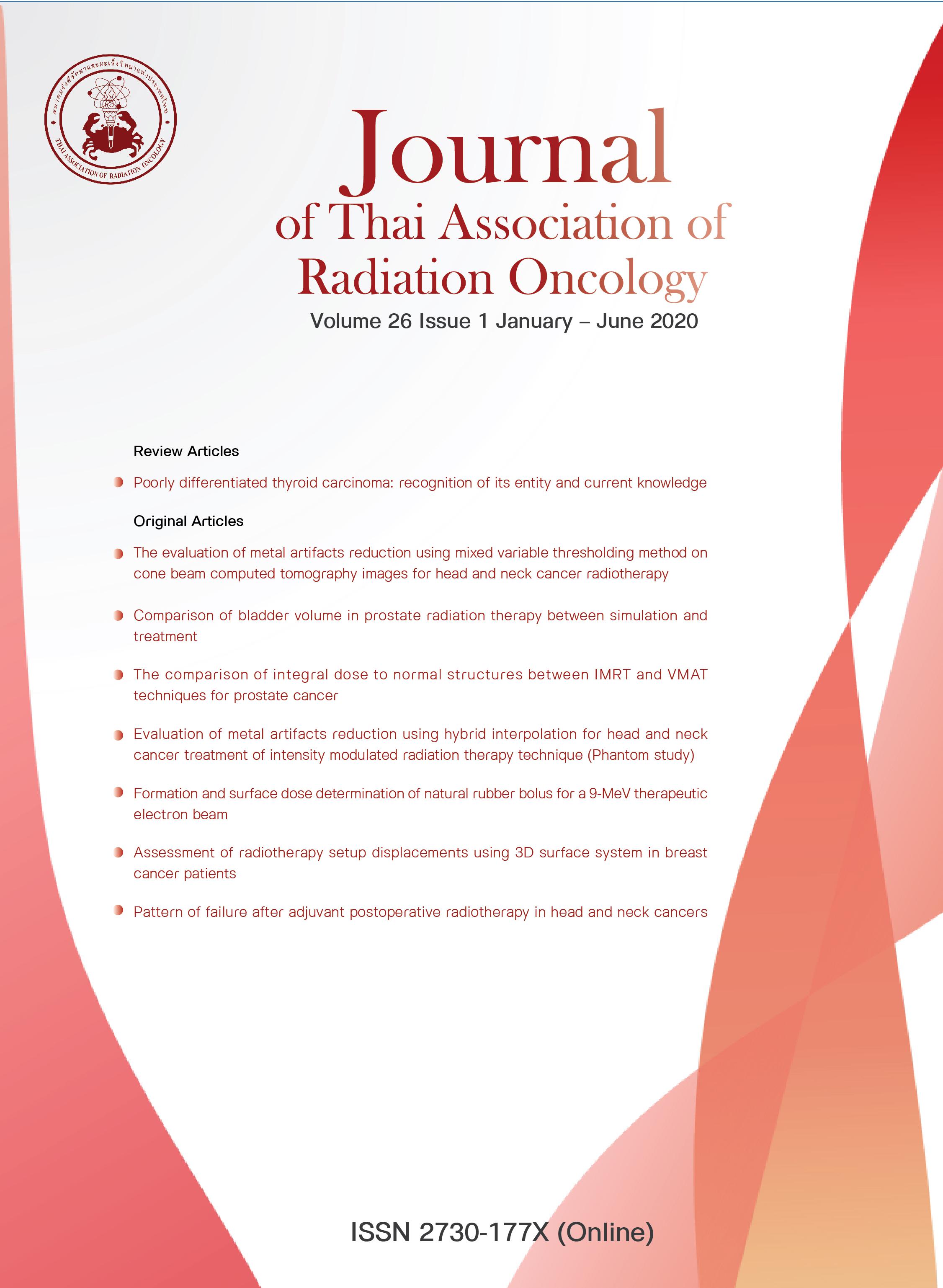Evaluation of Metal Artifacts Reduction using Hybrid Interpolation for Head and Neck Cancer Treatment of Intensity Modulated Radiation Therapy Technique (Phantom study)
Keywords:
Computed tomography, Dental implant, Metal artifacts, SimulationAbstract
Backgrounds: Radiation therapy for head and neck cancer treatment requires an accurate treatment plan to obtain a consistent dose and avoid the surrounding organs. Dental prosthetics or other artifacts, commonly found in computed tomography simulation images of the head and neck, produce metal artifact. Metal artifact obstructs the images of the surrounding organs and tissues. These images are unclear and cannot be effectively used in treatment planning, however, the artifacts can be reduced by an algorithm.
Objective: To develop a method for reducing metal artifacts in computed tomography simulation images of the head and neck with dental prosthetics before planning treatment with Intensity Modulated Radiation Therapy (IMRT)
Materials and methods: The efficiency of these three methods of reducing metal artifacts, (linear interpolation method (Li), total variation inpainting method (TV) and hybrid interpolation method (Hybrid)) were compared on the head and neck phantom images of an inserted metal screw and two metal screws. The time of the metal artifact reduction, line profiles, image data values and the shape of metal screws of both initial and reduced artifact images were evaluated.
Results: The average times of the hybrid interpolation method were 59.93 seconds and 148.71 seconds for a metal screw and two metal screws, respectively. The evaluated quality of the line profile, image data value and shape of the metal screws were similar to the TV method. Moreover, the hybrid method reduced metal artifact on the head and neck phantom images of two metal screws better than Li method.
Conclusion: Hybrid interpolation used less time than TV methods. The evaluated quality of the line profile, image data value and shape of the metal screws were similar to the TV method.
References
คณะกรรมการจัดทำแผนการป้องกันและควบคุมโรคมะเร็งแห่งชาติ. กรมการแพทย์กระทรวงสาธารณสุข, แผนการป้องกันและควบคุมโรคมะเร็งแห่งชาติ. พ.ศ. 2556-2560. กรุงเทพฯ: สถาบันมะเร็งแห่งชาติ; 2556.
Head and Neck cancers [cited Dec 1,2017]. Available from: https://www.chulacancer.net/education-inner.php?id=382
เอกซเรย์คอมพิวเตอร์ [cited Dec 5,2017] Available from: https://www.si.mahidol.ac.th/th/department/radiology/diagRadiology/knowCT.html
Edward F. B. and Dominik F. CT artifacts: Causes and reduction techniques. Imaging Med. 2012: 4, 229-240.
CT artefacts [cited Nov 30,2019]. Available from: https://www.radiologycafe.com/radiology-trainees/frcr-physics-notes/ct-artefacts
มะเร็งศีรษะและลำคอ [สืบค้นเมื่อวันที่ 1 ธ.ค. 2560]. Available from: : https://www.si.mahidol.ac.th/th/healthdetail.asp?aid=695
H. Xue, L. Zhang, Y. Xiao, Z. Chen, Y. Xing, Metal artifact reduction in dual energy CT by sinogram segmentation based on active contour model and TV inpainting, 2009 IEEE Nuclear Science Symposium Conference Record (NSS/MIC), Orlando, FL, 2009:904-908.
Kentaro M, Shinchiro M, Azusa H, Kensuke N, Masashi K. Single-energy metal artefact reduction with CT for carbon-ion radiation therapy treatment planning. Br J Radiol. 2016;89:20150988
Tongngarm W, Kaewlek T, Khamfongkhruea C, Udee N. Clinical application of K-means clustering algorithm for metal artifact reduction in computed tomography simulation images for intracavitary brachytherapy. Songkla Med J. 2016;34:119-129.
Wouter JH V, Raoul M S J, Aart J van der M, Jacob G. Development and validation of segmentation and interpolation techniques in sinograms for metal artifact suppression in CT. Med Phys. 2010;37:620-8.
กาญจนา พุทธบุรี และฐิติพงศ์ แก้วเหล็ก. การประเมินการลดสิ่งแปลกปลอมโลหะโดยการ ประยุกต์ใช้โทโทล วาริเอชั่น อินเพนทิ่ง สำหรับการจำลองการรักษาส่วนศีรษะและลำคอ. วิจัยและนวัตกรรม ขับเคลื่อนเศรษฐกิจและสังคม. 2560; 501-510.
ภิเษก รุ่งโรจน์ชัยพร. กลีเซอรอล : การใช้ประโยชน์เพื่อการผลิตแก๊สสไฮโดรเจน. วารสารวิทยาศาสตร์ ลาดกระบัง 2557; 23:140-159.
Xinhui D, Li Z, Yongshun X, Jianping C, Zhiqiang C, Yuxiang X. Metal artifact reduction in CT images by sinogram TV inpainting. 2008 IEEE Nuclear Science Symposium Conference Record. Dresden, Germany, 2008: 4175-4177.
Meyer E, Raupach R, Lell M, Schmidt B, Kachelriess M. Normalized metal artifact reduction (NMAR) in computed tomography. Med phys. 2010;37: 5482-5493.
Bar E, Schwahofer A, Kuchenbecker S, Haring P. Improving radiotherapy planning in patients with metallic implants using the iterative metal artifact reduction (iMAR) algorithm. Biomed Phys Eng Express. 2015; 1, 1-12.
Downloads
Published
How to Cite
Issue
Section
License
บทความที่ได้รับการตีพิมพ์เป็นลิขสิทธิ์ของวารสารมะเร็งวิวัฒน์ ข้อความที่ปรากฏในบทความแต่ละเรื่องในวารสารวิชาการเล่มนี้เป็นความคิดเห็นส่วนตัวของผู้เขียนแต่ละท่านไม่เกี่ยวข้องกับ และบุคคลากรท่านอื่น ๆ ใน สมาคมฯ แต่อย่างใด ความรับผิดชอบองค์ประกอบทั้งหมดของบทความแต่ละเรื่องเป็นของผู้เขียนแต่ละท่าน หากมีความผิดพลาดใดๆ ผู้เขียนแต่ละท่านจะรับผิดชอบบทความของตนเองแต่ผู้เดียว




